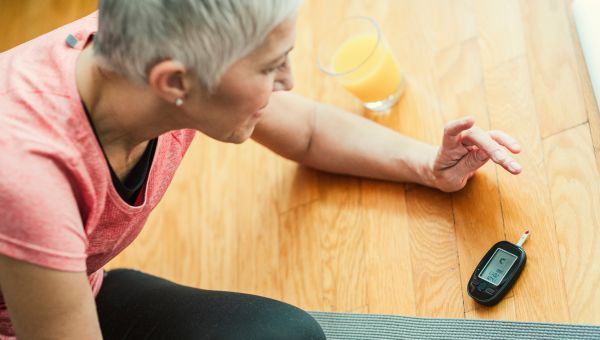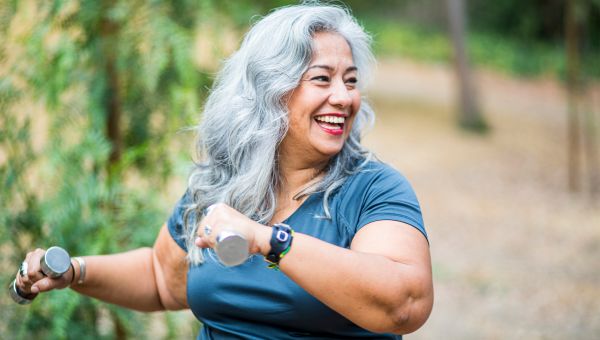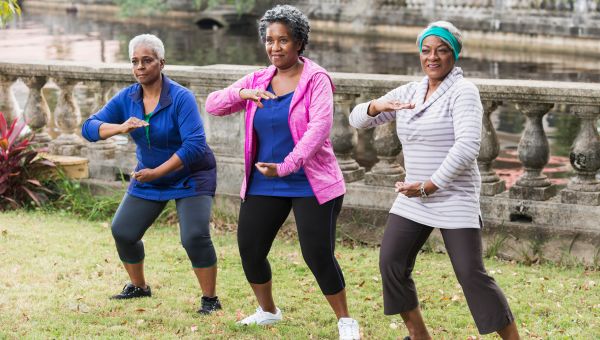How to Exercise With Type 2 Diabetes
Learn how working out helps control blood glucose—and discover the safest ways to get fit.

Getting regular exercise—along with following a healthy diet—is an important way to help manage your blood glucose levels, boost weight loss and reduce heart disease risks. But what kind of exercise, and how much, is necessary to reap those benefits?
The American Diabetes Association (ADA) recommends 150 minutes per week of aerobic exercise—brisk walking, swimming or riding your bicycle—spread out over three or more days with no more than two straight days without activity. Strength training is key, too: Think two to three sessions per week of moves like lifting dumbbells or using a resistance band. For older adults with diabetes, the ADA also advises including exercises that improve balance and flexibility (such as yoga or tai chi) two to three times per week.
Sound like a lot?
Don’t worry. That’s the goal. No one expects you to hit all these marks overnight. Whether you’re just starting out or looking to take your workout to the next level, here’s what you need to know.

Before you get started
Exercise helps lower blood glucose because it removes glucose from your blood and uses it for energy. Your body also stores glucose in your muscles and liver, and the glucose from these sources fuels your workouts.
But sometimes exercising can cause your blood glucose to drop too low, putting you at risk for what’s known as hypoglycemia. That’s one reason why it’s important to get your healthcare provider’s okay before you begin an exercise program or make any big changes to your workout. You should also consult your doctor to make sure that your exercise regime is appropriate and safe for your level of cardiovascular fitness.

Track your blood glucose
To exercise safely, you’ll need to see how your blood glucose responds to different types of physical activity. Check your blood glucose before and after—and possibly during—exercise to be sure it’s at a sufficient level. If it isn’t, eat a snack. Generally, it’s recommended that your blood glucose should be between 100 mg/dl and 250 mg/dl before starting a workout. Check with your health care provider for your recommended range and discuss any necessary adjustments to your medication.
Several classes of diabetes medications have the potential to induce low blood sugar (hypoglycemia) during or after exercise, while other medications carry little or no risk of hypoglycemia. According to the ADA and the American College of Sports Medicine, adjusting medication for physical activity is generally necessary only for people with diabetes who use insulin or oral medications that stimulate insulin secretion, such as sulfonylureas (including glyburide, glipizide and glimepiride) or meglitinides (including nateglinide and repaglinide).
Don’t forget to continue monitoring your blood glucose after your workout ends to be on the lookout for later-onset hypoglycemia, which can occur when your body’s carbohydrate stores become depleted. High-intensity exercise in particular may heighten this effect.

Look out for blood glucose dips
While you’re exercising, you should be prepared in case your blood glucose drops too low. Remember to take along carbohydrates that can bring your blood glucose levels up. The ADA’s preferred treatment for someone with blood glucose below 70 mg/dl who’s still conscious is 15 to 20 grams of fast-acting glucose (the amount found in four to five glucose tablets or one glucose gel tube). But any form of carbohydrate that contains glucose—such as 4 to 6 ounces of regular-sugar juice or soda or 1 tablespoon of sugar, honey or fruit jelly, for instance—is typically okay.

Stay hydrated
It’s also important to stay properly hydrated when you exercise. Check with your doctor about what amounts of water or other drinks you should take in before, during and after your workout so that you can be sure to replace the essential fluids you lose while you sweat.

Prepare for possible emergencies
Carry a cell phone when you exercise, especially if you like to work out alone, and wear a medical alert bracelet. If you’re unable to speak, a medical ID tag can be a lifesaver, alerting strangers and first responders to your name, diabetes status, contact information and emergency instructions.

Start (and finish) with a stretch
Once you’ve done your preparation for working out, it’s time to get moving. Doing stretches increases flexibility (which helps improve range of motion), prevents stiffness and enhances coordination, reducing your chance of injury. A study published in the Journal of Physical Therapy Science suggests that stretching also helps people with type 2 diabetes manage their blood glucose levels.
Warm up and cool down with easy stretches for about five minutes before and after each workout. Breathe slowly and deeply while holding each move and don’t bounce. You should only feel mild tension when you stretch. If you feel pain, pull back or stop.

Get your heart rate up
Aerobic exercise is a key component of any routine, as it improves your overall cardiovascular fitness. The best way to stick with a program? Pick an activity you enjoy that complements your lifestyle. Walking, for example, is a low-cost, easy-on-the joints exercise that fits into just about any schedule. For maximum aerobic benefit, walk briskly and keep up a steady pace.
Just starting out? Work up to 150 minutes per week by breaking up your walks into shorter bouts of 10 minutes until you reach the ADA’s ideal goal of 30 minutes a day, fives times per week. Wear a pedometer or a fitness tracker to measure your progress or use an app like Sharecare (available for iOS and Android) to gauge your daily steps. When possible, take your walk outdoors. Studies show it can improve your mood and reduce stress.
Swimming is another great option for a joint-friendly, calorie-burning workout. And since water provides resistance, swimming has the added benefit of building muscle tone. If you’re new to swimming, shoot for 10 minutes per workout, three times per week. Then gradually increase your time to about 30 minutes. A water aerobics class is another good option. Be sure to let the class instructor or lifeguard know about your condition before taking the plunge.

Make time for strength training
Building muscle mass is important for everyone—strong muscles boost metabolism, strengthen bones, help with weight loss and improve cardiovascular health, among other benefits. If you have type 2 diabetes, it also makes it easier to manage your glucose levels when combined with a regimen that also includes aerobic activity.
In a study published in 2015 in the Journal of the American Medical Association, 262 sedentary adults with type 2 diabetes were divided into four groups. One did strength training three times a week for nine months, another group did aerobic exercise, the third group did both types of exercise and the fourth didn’t exercise at all. The researchers found that blood glucose improved only for those doing a combination of aerobics and strength training.
The ADA recommends two to three sessions of strength training (also known as resistance training) per week on nonconsecutive days. Not sure where to begin? This simple routine uses exercise bands to tone your body from head to toe. Include both aerobic and strength training in your weekly regimen to reap greater rewards.

Prioritize flexibility and balance
The ADA recommends that older adults with diabetes do exercises that improve flexibility and balance two to three times per week. Why is that important? While stretching improves joint flexibility and range of motion, activities like tai chi and yoga help prevent falls by improving balance and gait. It’s important to perform the poses correctly to avoid injury. This beginner’s yoga video can help you get started.

Keep moving throughout the day
In addition to regular exercise, the ADA recommends that all adults—especially people with type 2 diabetes—interrupt prolonged periods of sitting with a few minutes of light physical activity every 30 minutes. It may help prevent type 2 diabetes if you’re at risk. And if you have type 2, it may help you better manage your blood glucose levels.
Research published in 2016 in Diabetes Care showed that, for adults with type 2, breaking up bouts of sitting every 20 to 30 minutes with three minutes’ worth of movement—a leisurely walk or simple resistance moves such as standing push-ups against a wall or counter—improved blood glucose levels compared with uninterrupted sitting. To get into the habit, set a reminder on your phone or install a timer app on your computer.
More On


video

slideshow


video


video
